The Crip Couture Manifesto
(listen to this selection, read by Diane R. Wiener)
Artists explore and define boundaries. Artists investigate and search for meaning through materials, space, and time. Artists document the past and present; they create, imagine and envision the future. The Crip Couture Manifesto is a set of guiding principles that defines the methodology of my work and the philosophy behind my practice. It states my intentions and my position as a disabled woman artist of color who uses wearable art as a medium to articulate new meanings of disability generated from Crip identity, Crip specificity, Crip relationality, and Crip collective care. It also offers ideas and directions for researchers, artists, art therapists, activists, and cultural workers to apply aspects of Crip Couture in their work.
A disability art and culture movement that aims to improve the quality of the human race through Crip-led, radical care work in making wearable art objects by, for and with disabled people that can incorporate their full, intersectional identities. As an art genre within the Disability Art Movement, Crip Couture considers disabled people to be “well-born,” even though eugenicists have claimed otherwise. Crip Couture believes that our complex embodiment is the source of knowledge; its art making practice explores and creates new meanings around disability. Crip Couture operates as an instigator for challenging ableism-based practices in the arts and in social relationships through its critical production processes and aesthetic choices. Crip Couture is a trendsetter, a platform for providing concepts, language, tools and methods for an alternative, non-assimilationist way to create disability representations according to disability justice activist culture.
Crip Couture’s creations are based on the agenda and issues identified by people who are Sick (chronically ill), Mad, Autistic, Disabled and Deaf people (S.M.A.D.D.) who are from a diverse range of race, class, and gender identity expressions. Crip Couture also creates room for people who may not have had the opportunity to claim a disability identity or connect to a disability activist community. Crip Couture aims to hold a space for people who may come out Crip during their involvement with Crip Couture projects and even those who are still questioning their disability identity. Crip Couture offers mentorship opportunities to Crip artists and fashion creatives who share the same working ethics and passions for Crip culture.
Crip Couture is the disability culture version of Haute Couture, high fashion. Disability culture’s high fashion production is one of a kind and limited edition. Haute Couture has a history of being class exclusive and expensive. Crip Couture also has an exclusive nature, its “clientele” is disabled people only, but it’s wearable art and body adornments have no price tags. Haute Couture originally came from an ableist, sexist, white elite business operation. Crip Couture is conceptualized by me, who roots Crip Couture in disabled people’s desire, healing, community ties, and activism. Haute Couture’s creations are luxury designer items. Haute Couture wearers’ physicality and body shapes conform to the beauty standards for the pleasure of the male gaze. In contrast, Crip Couture creates work for disabled people’s pleasure: wearable art as objects made to serve as adornments, assistive aids, protections, armor, archive and interlocutor of disability experiences.
Crip Couture is a tailor-made process. Similar to Haute Couture, which takes a large team of people executing intensive labor needlework, Crip Couture is also labor intensive, both in its physical and emotional labor. Crip Couture makers follow Crip time: the design ideas do not arrive based on the production speed required by capitalism. Crip Couture’s production processes starting from initiating ideas, to crafting plans, to choosing material, to method, and to the final presentation are creative and relational (intrapersonal and interpersonal) engagements. The conception for each Crip Couture piece only arrives when the makers bend time to their own and each others’ physical, mental, emotional, psychological and spiritual locations and state of mind.
The artistic choices, such as patterns, colors, shapes, dimensions, textures, temperature of the materials and construction methods, used to create the wearable art, all reflect the density and felt feelings of the wearer’s personal narratives and the maker’s relational responses to the wearer’s needs, experiences and desires. Crip Couture considers such relational accountability as a part of the aesthetic expression. Crip Couture maps the meaning of Crip intimacy through this process of building relationships. This is a critical part of the integrity of Crip Couture.
S.M.A.D.D. people may participate in Crip Couture projects as models or collaborators. They are welcome to define their roles and level of involvement, including but not limited to the role of a narrative based content provider, consultant, or receiver of personal care support. Crip Couture makers’ lived experiences and physical impairments bring specific sets of tools and skills into the making, which is absent in Haute Couture and the larger fashion industry. In the world of Crip Couture, the makers’ impairments naturally determine the construction methods and the aesthetic choices made for the wearable art. The way that the makers choose to handle tools, materials and sewing machines are not “adapting” able-bodied makers’ procedures nor methods. Their use of assistive aids or personal assistants is not to “compensate” for their impairment. Rather, the use of assistive aids is a deliberate innovation choice and a way to exercise interdependency. Such “Crip touch” serves as an artist’s signature and style.
Crip Couture works on unveiling and challenging problematic disability representations, including framing disability experiences in binary terms, for example, “beautiful vs ugly,” “normal vs abnormal,” and “healed vs broken,” etc. These binary terms position disabled people in opposition to the nondisabled standards, they overlook the systematic issues that disabled people experience. Crip Couture cautions the use of overcoming narratives and inspiration porn, which are often used to please the nondisabled audience by tokenizing disabled people. Crip Couture’s wearable art presents the complexity of disability instead of simply flipping the binary. By creating in-your-face disability representations that pride themselves in being non-compliant to the ableist expectations, Crip Couture intends to re-program society’s limited imaginations of disability.
Crip Couture’s aim is not to mass produce adaptive clothing for disabled people. Crip Couture’s concepts, philosophy and methodology are to challenge both disabled and nondisabled designers, artists and fashion companies’ approaches to making wearable garments and accessories for disabled people. Crip Couture’s production is made as an instigator for broadening the existing fashion production practices beyond their material, commodity values. Crip Couture functions as a trendsetter for generating disability-culture and disability justice-informed art and design productions and community building.
As a conscious-raising and action-generating movement, Crip Couture has the potentials to target, diagnose, treat and rehabilitate the undesirable human traits and desires, such as avoidance of disabled people’s multiple identities, symptoms of pity/condescending tears and self-projected fear onto Crips, overdose of ableist thinking or denial of able-bodied privileges.
Crip Couture is a type of care work that revolutionizes the meanings of eugenics, first coined by Charles Darwin’s cousin Sir Francis Galton, who defined eugenics as “well-born.” In the world of Crip Couture, S.M.A.D.D. people are considered well-born because this world is all about the survival of the Crippest. Crip Couture’s productions serve as a symbol of resistance against the harm created by ableism and other systems of oppression.
Crip Couture models a relational design method, which requires the designer/artist/maker integrate access intimacy and understand the relational/political model of disability in their creative work. The artist/designer’s production process requires time and energy for building relationships and the nature of creating wearable art objects is in and of itself a gesture of holding/nurturing the bodymind. Wearable art objects created under the guideline of Crip Couture are the embodiment of the wearer’s history, lived experiences and narratives; the production process therefore is a form of providing care. As an artistic engagement process, Crip Couture’s philosophy can make an impact on the ways that disabled people are treated in the mental health care system.
Crip Couture is a hub for brewing a sustainable Crip siblinghood and family. Its wearable art and artistic social engagements are made to attend to the unknowns, joy, confusion, pleasure, sorrow, bliss, anger—a whole spectrum of feelings from living as a disabled person with multiple identities and cultures. Crip Couture prioritizes its practice on supporting Crips finding each other, on our terms; finding history and legacy in fellow Crips. Crip Couture advocates for Crip self-love/self-care be built based on community love/community-care.
Images of work by Chun-shan (Sandie) Yi:
Title: Em-brace
Plastic, embroidery thread and fabric
12 x 11 x 3
2011
Model: Sunaura Taylor
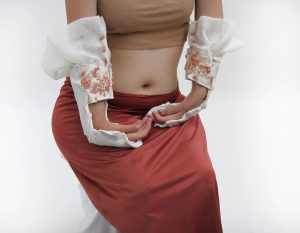
- A Caucasian model rests both of her hands on her hips. She wears a coral colored skirt and a beige bandeau, which is a strip of garment covering her breasts. A pair of white, L-shaped wrist braces cradle her wrists, which naturally curve inwards. Her fingers curve and rest gently next to each other. The L-shaped braces have a hard surface, but with organic, wavy edges close to the model’s hands. The model’s forearms are cuffed with soft and creamy fabric embroidered with clusters of white and pinkish French knots (tiny ball shaped stitches). A thin mesh fabric forms ruffles on the top of the braces. The model sits on a chair wrapped in white fabric.
Plastic, embroidery thread and fabric
12 x 11 x 3
2011
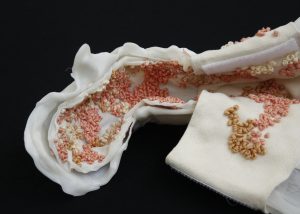
- A close shot of a L-shaped wrist braces with curvy plastic wedges. The braces’ interior is lined with a soft and creamy fabric embroidered with clusters of white and pinkish French knots (tiny ball shaped stitches).
Title: Dermis Footwear
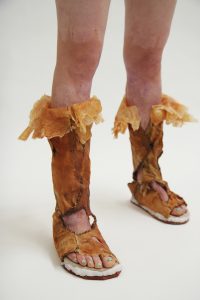
- A caucasian model wearing a pair of open-toe, calf-height boots, which are mostly made with latex and plastic. This pair of boots has an uneven skin-like surface, where thick scars form creases and bumps in brownish, orange and beige colors. Skin-like latex pieces lightly drape themselves like flower petals blooming on top of the boots. Large openings on the front and side of the boots reveal the model’s burn scars. The model’s scars from skin graft surgeries are also revealed on her knees and lower thighs. Black stitches are used to hold the wall of the boots together. The model’s toes have turquoise nail polish. Parts of the soles were made with a layer of white plastic, which has an organic, fluid quality.
Title: Hairy Undies (Series #2)
Fabric, thread & donated hairs
18 x 8 x 1
2018
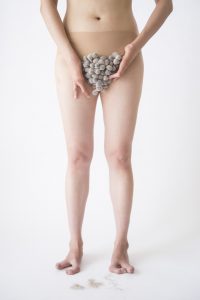
- A full-frontal shot of the lower torso of a woman of color, wearing an undie stitched with a cluster of fabric balls on the pubic area. These fabric balls contain short pieces of hair. She has two fingers on each hand and two toes on each foot. Each of her hands cradles the pubic area on each side. Small clusters of fine hair have dropped on the floor right next to her toes.
Title: Skinny
Human skin, silk organza, thread and body cream, varies
object varies, each panel is 11 x 14
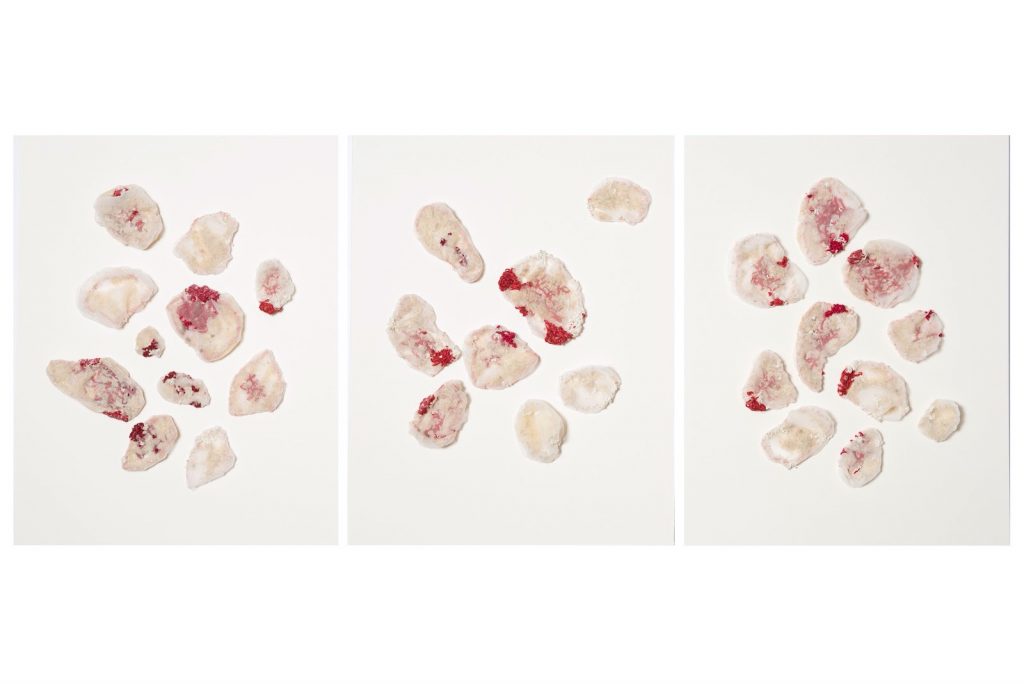
- Three panels, each contains small sacs made with transparent/silky fabric. The shapes of the sacs vary organically. Tiny pieces of human skin flakes rest inside the sacs. They are embroidered with red, salmon colored and white threads.
-
“Disability Futures in the Arts” is supported by the Canada Council for the Arts/Conseil des arts du Canada.
Back to Top of Page | Back to Disability Futures in the Arts | Back to Volume 14, Issue 4 – December 2020
About the Author
Chun-shan (Sandie) Yi has a MFA degree from the University of California Berkeley and a MA in art therapy from the School of the Art Institute of Chicago. She is a disabled artist and disability culture worker whose work, Crip Couture, focuses on wearable art made for and with disabled people. Sandie recently defended her Ph D dissertation in Disability Studies at the University of Illinois at Chicago. Sandie was the artist-in-residence and her work “Project ImPerfect, baby onesies” is in the permanent collection at Access Living. Her research interests include Disability Arts and Culture; disability fashion; accessibility design and programming for arts and cultural venues; and social justice-based art therapy. She is the program director of Disability Culture Activism Lab (DCAL), a partnering project with the Department of Art Therapy and Counseling at the School of the Art Institute of Chicago. Her work can be found: http://www.cripcouture.org